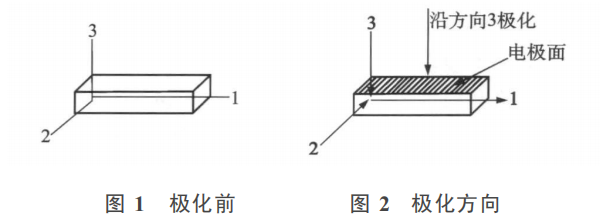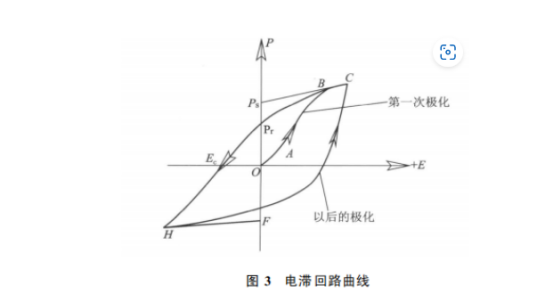Hubei Hannas Tech Co.,Ltd-Professional Piezoceramic Elements Supplier
Hot Keywords:
- All
- Product Name
- Product Keyword
- Product Model
- Product Summary
- Product Description
- Multi Field Search
Views: 0 Author: Site Editor Publish Time: 2023-02-13 Origin: Site








Polarization of piezoelectric ceramics
Before the piezoelectric ceramic material is not polarized, the free electrons are arranged in disorder; after the polarization treatment, remanent polarization is generated along the polarization direction to become an anisotropic polycrystal, the free electrons tend to be consistent, and the piezoelectricity is greatly enhanced. As shown in Figure 1 and Figure 2, piezoelectric ceramic materials can be made into shapes and polarization directions. The piezoelectric ceramic materials before and after polarization have different dielectric constant ε and piezoelectric constant d.

Set the dielectric constant before polarization: ε11 = ε22 = ε33. If the s is polarized along direction 3, the other two electrode faces are perpendicular to the polarization direction. The dielectric constant after polarization: ε11 = ε22 ≠ ε33, and the value of ε33 is much larger than that of ε11.

The piezoelectric constant of piezoelectric ceramics is also anisotropic, and the value of the piezoelectric constant d along different directions is also different. Among them, the value along direction 3 is large, that is, d 33 >>d 31 and d 32 . If measured with a galvanometer, there is only current in d33, and no current is generated in the other two directions. The polarization of piezoelectric ceramics is very similar to the magnetization of magnets, and the magnetic field strength will change greatly before and after magnetization.
Hysteresis circuit of piezoelectric ceramics
Piezoelectric ceramics sphere is polycrystalline, and when its temperature is higher than the Curie temperature Tc, it is a cubic lattice; when its temperature is below the Curie temperature Tc, it is a tetragonal lattice and has piezoelectricity. The phenomenon that the piezoelectric material can change the internal structure of the material at the temperature Tc is called solid-state phase transition, and Tc is called the phase transition temperature, also known as the Curie temperature. Different piezoelectric materials have different Curie temperatures.
For example, the Curie temperature Tc of BaTiO3 is 120 °C, and that of PbTiO3 is 490 °C. When the temperature rises to Tc, the three side lengths of the cubic unit cell are equal, that is: a = b = c, at this time the charge center is located in the center of the cube, and piezoelectric ceramics have no piezoelectricity. When the temperature is lower than Tc, the lengths of the three sides of the tetragonal unit cell are not equal, namely: a = b
Ferroelectricity appears when piezoelectric ceramics are polarized. After the second polarization, a loop curve will be formed, as shown in Fig. 3 [1].

In the figure, Ps is the spontaneous polarization; Pr is the remanent polarization; Ec is the coercive field strength.

It can be seen from the hysteresis loop curve after polarization that it is very similar to the hysteresis loop curve, so piezoelectric ceramics are also called ferroelectrics. After one polarization, there is a remanent polarization Pr, which changes along this curve each time afterward. Different piezoelectric materials have different hysteresis loops.
An alternating electric field is applied to the piezoelectric ceramic body, and the hysteresis curve can be directly observed through an oscilloscope. When the electric field increases to a certain intensity, the polarization intensity reaches saturation. Among them, the BC section is a linear increase, Ps is the spontaneous polarization intensity, when the electric field is zero, the polarization intensity is not equal to zero, and P r is the remanent polarization intensity. When the electric field is reversely increased to Ec, the polarization is zero. Since the Ec point can make the polarization intensity of piezoelectric ceramics zero, Ec is called the coercive field strength. When the electric field increases in the opposite direction, the polarization intensity also increases in the opposite direction. When the reverse polarization intensity reaches saturation, and then reduce the reverse electric field, the polarization intensity will change along the curve HFC line.
Polarization process is a very complicated process. Not only must a high electric field be required during polarization, but different thicknesses require different times, and the best polarization effect must be achieved at a relatively high temperature. The polarized piezoelectric ceramic material will lose the polarization effect at a certain high temperature, and different piezoelectric materials have different failure temperatures, which should be paid attention to when selecting piezoelectric ceramic materials. The polarization performance of piezoelectric ceramics, the performance difference between piezoelectric ceramic materials before and after polarization is very large.
Products | About Us | News | Markets and Applications | FAQ | Contact Us